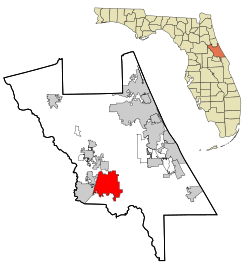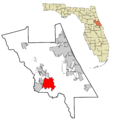Deltona, Florida facts for kids
Quick facts for kids
Deltona, Florida
|
||
|---|---|---|
|
||
| Motto(s):
"I'm Proud To Be A Part Of It!"
|
||

Location in Volusia County and the state of Florida
|
||
| Country | United States | |
| State | Florida | |
| County | Volusia | |
| Established | November 18, 1962, as Deltona Lakes | |
| Incorporated | December 31, 1995, as the City of Deltona | |
| Government | ||
| • Type | Commission–Manager | |
| Area | ||
| • City | 40.84 sq mi (105.79 km2) | |
| • Land | 37.32 sq mi (96.67 km2) | |
| • Water | 3.52 sq mi (9.12 km2) 8.5% | |
| Elevation | 33 ft (10 m) | |
| Population
(2020)
|
||
| • City | 93,692 | |
| • Density | 2,510.23/sq mi (969.21/km2) | |
| • Urban | 210,712 (183rd U.S.) | |
| • Urban density | 1,933.4/sq mi (746.5/km2) | |
| • Metro | 668,921 (88th U.S.) | |
| Demonym(s) | Deltonian | |
| Time zone | UTC−5 (EST) | |
| • Summer (DST) | UTC−4 (EDT) | |
| ZIP codes |
32725, 32738
|
|
| Area code(s) | 321, 386, 407 and 689 | |
| FIPS code | 12-17200 | |
| GNIS feature ID | 0281490 | |
| Interstate(s) | ||
| Major State Road(s) | ||
| Waterway(s) | St. Johns River | |
Deltona is a city in Volusia County, Florida, United States. It is located on the northern shore of Lake Monroe. In 2020, about 93,692 people lived there.
Deltona is a main city in the Deltona–Daytona Beach–Ormond Beach metropolitan area. This area had about 685,344 people in 2021. It is also the second largest city in the Greater Orlando combined statistical area.
The city was first called Deltona Lakes. It was built as a planned neighborhood by the General Development Corporation and the Mackle Brothers. It opened in 1962 and grew very quickly. The Mackle Brothers marketed small, affordable homes around the world. Deltona is mostly a place where people live. Many residents travel to work in nearby cities like Orlando and Daytona Beach.
Contents
History of Deltona
The area where Deltona is now was once home to the Timucuan people. They were nomads who found lots of fish and fresh water.
Early Settlers
Florida became a state in 1845. After this, steamboats started traveling up the St. Johns River to Lake Monroe. George Sauls and his family were the first settlers in this area in 1859. Their home was about 3 miles (4.8 km) north of Osteen. The street where they lived was later renamed George Sauls Street in 1977.
How Deltona Lakes Began
In 1962, the Mackle Brothers (Elliott, Robert, and Frank Mackle) bought 17,203 acres of land. They planned to build a new community called Deltona Lakes. It officially opened to buyers on November 18, 1962. The plan included areas for homes, parks, shops, and even a golf course.
Deltona Lakes was advertised all over the United States. Sales representatives also marketed homes in places like Germany, Puerto Rico, and Latin America.
Growing Fast
By November 1965, Deltona Lakes had almost 1,600 people. Nearly 1,000 homes were built or being built. There were also over 120 miles (193 km) of paved roads. By September 1966, the population grew to 2,413. More families moved in, and property sales reached US$60 million.
In April 1967, over 30 clubs formed in the community. These included golf clubs, a shuffleboard club, and a bicycle club. By 1970, Deltona Lakes had about 4,868 people. It continued to grow, reaching 51,828 people by 1990.
Becoming a City
Residents tried to make Deltona Lakes a city in 1987 and 1990. They finally succeeded in 1995. A city charter was approved on September 9, 1995. A seven-member city commission was elected. Deltona Lakes officially became the City of Deltona on December 31, 1995. Its name was shortened to Deltona.
By 2000, the city's population reached 69,543. This made it the largest city in Volusia County. The first city hall was built in 2001 and opened on March 16, 2002. A branch campus of Daytona State College also opened in Deltona in August 2004.
Modern Deltona
City leaders are now working to bring new businesses and industries to Deltona. They have set aside special areas for offices, healthcare, and other businesses. This helps the city grow and create more jobs.
Geography and Climate
Deltona is in southwestern Volusia County, in Central Florida. It is about 25 miles (40 km) from the Atlantic Ocean. The city is located halfway between Daytona Beach and Orlando.
Surrounding Areas
Deltona is surrounded by several other towns. To the north are Lake Helen and Cassadaga. DeLand is to the northwest, and Orange City is to the west. DeBary is southwest, Enterprise is south, and Osteen is southeast.
Land and Water
Most of Deltona's land has rolling hills and many lakes. The St. Johns River flows through Lake Monroe, just south of the city. The city's elevation is about 33 feet (10 m) above sea level. Some areas are as low as 20 feet (6 m) and as high as 112 feet (34 m).
In 2010, Deltona covered about 41.1 square miles (106.4 km2). About 37.5 square miles (97.1 km2) is land, and 3.5 square miles (9.1 km2) is water.
Weather in Deltona
Deltona has a humid subtropical climate. This means it has hot, humid summers and mild winters. The highest temperature ever recorded was 103 °F (39 °C) in July 1998. The lowest was 19 °F (−7 °C) in January 1985.
The city gets about 53 inches (135 cm) of rain each year. The wettest months are from June to September. The hurricane season runs from June 1 to November 30. September is the month most likely to have hurricanes. In 2004, Hurricane Charley passed directly over Deltona. The city also felt the effects of Hurricane Frances and Hurricane Jeanne that same year.
| Climate data for Deltona, Florida | |||||||||||||
|---|---|---|---|---|---|---|---|---|---|---|---|---|---|
| Month | Jan | Feb | Mar | Apr | May | Jun | Jul | Aug | Sep | Oct | Nov | Dec | Year |
| Record high °F (°C) | 89 (32) |
89 (32) |
92 (33) |
96 (36) |
100 (38) |
102 (39) |
103 (39) |
100 (38) |
98 (37) |
96 (36) |
92 (33) |
88 (31) |
103 (39) |
| Mean daily maximum °F (°C) | 70 (21) |
72 (22) |
77 (25) |
81 (27) |
87 (31) |
90 (32) |
92 (33) |
92 (33) |
89 (32) |
83 (28) |
78 (26) |
72 (22) |
82 (28) |
| Mean daily minimum °F (°C) | 47 (8) |
49 (9) |
54 (12) |
57 (14) |
63 (17) |
69 (21) |
71 (22) |
71 (22) |
70 (21) |
64 (18) |
57 (14) |
50 (10) |
60 (16) |
| Record low °F (°C) | 19 (−7) |
25 (−4) |
27 (−3) |
36 (2) |
45 (7) |
52 (11) |
60 (16) |
64 (18) |
52 (11) |
39 (4) |
30 (−1) |
19 (−7) |
19 (−7) |
| Average precipitation inches (mm) | 2.88 (73) |
2.96 (75) |
3.80 (97) |
2.55 (65) |
3.53 (90) |
6.41 (163) |
7.02 (178) |
7.23 (184) |
5.88 (149) |
3.56 (90) |
2.96 (75) |
2.53 (64) |
51.31 (1,303) |
| Source: The Weather Channel | |||||||||||||
People of Deltona
| Historical population | |||
|---|---|---|---|
| Census | Pop. | %± | |
| 1970 | 4,868 | — | |
| 1980 | 15,710 | 222.7% | |
| 1990 | 50,828 | 223.5% | |
| 2000 | 69,543 | 36.8% | |
| 2010 | 85,182 | 22.5% | |
| 2020 | 93,692 | 10.0% | |
| U.S. Decennial Census | |||
Population Growth
Deltona has grown a lot over the years. In 1970, there were about 4,868 people. By 2020, the population had grown to 93,692.
Diversity in Deltona
Deltona is a diverse city. In 2020, about 37.63% of the people were Hispanic or Latino. Many Hispanic residents are Puerto Rican. Other groups include Cuban, Mexican, and Dominican people.
| Race / Ethnicity (NH = Non-Hispanic) | Pop 2000 | Pop 2010 | Pop 2020 | % 2000 | % 2010 | % 2020 |
|---|---|---|---|---|---|---|
| White (NH) | 50,540 | 48,502 | 42,893 | 72.67% | 56.94% | 45.78% |
| Black or African American (NH) | 4,478 | 8,058 | 9,837 | 6.44% | 9.46% | 10.50% |
| Native American or Alaska Native (NH) | 203 | 236 | 200 | 0.29% | 0.28% | 0.21% |
| Asian (NH) | 629 | 988 | 1,328 | 0.90% | 1.16% | 1.42% |
| Pacific Islander or Native Hawaiian (NH) | 28 | 29 | 61 | 0.04% | 0.03% | 0.07% |
| Some other race (NH) | 73 | 180 | 533 | 0.10% | 0.21% | 0.57% |
| Mixed race or Multiracial (NH) | 845 | 1,455 | 3,581 | 1.22% | 1.71% | 3.82% |
| Hispanic or Latino (any race) | 12,747 | 25,734 | 35,259 | 18.33% | 30.21% | 37.63% |
| Total | 69,543 | 85,182 | 93,692 | 100.00% | 100.00% | 100.00% |
Economy and Jobs
In 2013, about 60% of people aged 16 and over in Deltona were working or looking for work. Most people worked in sales, office jobs, or management. Many also worked in healthcare, retail, and education.
Most workers (82.7%) had jobs in the private sector. About 12.7% worked for the government. Most people (85.9%) drove alone to work. The average commute time was 32 minutes.
Some of the largest employers in Deltona include Daytona State College, Publix Supermarkets, and Walmart.
Education in Deltona
Deltona has many schools for students of all ages. In the 2012–2013 school year, about 11,877 students were in public schools.
Schools in Deltona
Volusia County Schools (VCS) manages the public schools in Deltona.
- There are 2 public high schools:
* Deltona High School * Pine Ridge High School
- There are 3 middle schools:
* Galaxy Middle School * Heritage Middle School * Deltona Middle School
- There are 7 elementary schools within the city limits.
Some schools in nearby towns also serve parts of Deltona. These include University High School in Orange City and elementary schools in Enterprise, Osteen, and Lake Helen.
Higher Education
For those who want to continue their education, Daytona State College has a campus in Deltona. Bethune-Cookman University also offers programs there.
Private Schools
Deltona also has several private schools:
- Deltona Adventist School
- Deltona Christian School
- Good Shepherd Academy
- Trinity Christian Academy
Elementary schools
- Deltona Lakes Elementary School
- Discovery Elementary School
- Forest Lake Elementary School
- Friendship Elementary School
- Pride Elementary School
- Spirit Elementary School
- Sunrise Elementary School
- Timbercrest Elementary School
Middle schools
- Deltona Middle School
- Galaxy Middle School
- Heritage Middle School
High schools
- Deltona High School
- Pine Ridge High School
Private schools
- Deltona Adventist School
- Deltona Christian School
- Good Shepherd Academy
- Trinity Christian Academy
Additional public schools serving Deltona
- University High School (in Orange City)
- Enterprise Elementary School (in Enterprise)
- Osteen Elementary School (in Osteen)
- Volusia Pines Elementary School (in Lake Helen)
Footnotes
Media and Culture
Deltona is part of a large media market that includes Orlando, Daytona Beach, and Melbourne. This means residents can access many radio and TV stations.
Local News
The main daily newspapers for Deltona are the Orlando Sentinel, The Daytona Beach News-Journal, and the West Volusia Beacon. There is also El Sentinel, which is the Spanish version of the Orlando Sentinel. The city also has its own online TV channel, Deltona TV. It shows city meetings and local programs.
Library and Nature
Deltona has one public library called the Deltona Regional Library. It is part of the Volusia County Public Library system. The library is very large, about 50,000 square feet (4,645 m2). It also has an environmental learning center and an outdoor amphitheater for events. The building is designed to be eco-friendly.
Next to the library is the Lyonia Preserve. This is a 360-acre (146 ha) area that helps protect and restore the local scrub habitat. The Lyonia Environmental Center at the library teaches people about Volusia County's ecosystems. It also encourages people to help with conservation efforts.
Notable People
Many interesting people have connections to Deltona:
- Chad Brown (born 1996), a basketball player
- Montana DuRapau, a former baseball pitcher for the Pittsburgh Pirates
- Paxton Lynch, a former football quarterback for the Pittsburgh Steelers
- John Masiarcyzk Sr., who was the first and third mayor of Deltona
- Dennis Mulder, a business owner and the second mayor of Deltona
- David Santiago, a former city commissioner and vice mayor, and a current Florida State Representative
Images for kids
See also
 In Spanish: Deltona para niños
In Spanish: Deltona para niños




